How We Climbed an Iconic Norwegian Mountain for an Epic Aurora Photo
![]()
On March 23rd, 2023, Earth got hit by the strongest geomagnetic storm in six years. I was out executing my unique aurora shot of the year, titled The Platform.
Aurora photography has now become my signature and I have built a name for myself with it in recent years by building compositions around the incredible phenomena. Some more of my work has won prizes in recent days, such as my photo “The Guts” being awarded first prize in the “People & Nature” category at the World Nature Photography Awards in 2022, and also featured in The Guardian and National Geographic Spain.
When I plan a photography project, my aim is to find some “never before seen” aurora photographs. I want to capture the northern lights in a way we never see them, to be able to enhance their uniqueness and spontaneity. I want my images to be completely unrepeatable even for myself.
Some of my photography work takes a huge amount of time and many attempts before capturing the right moment – sometimes spread over a few winters. This is why I want to share the stories behind the photos I take, and I wish to show how and why I captured The Platform, my unique aurora shot of 2023.
Why This Location?
Otertinden in the valley of Signaldalen in Norway is a very famous mountain photographed by many. It has become an icon over the years due to its incredible shape and dramatic rugged summits composed of two major cliff sides.
I was named one of the best northern light photographers of the year in 2021 thanks to a photo titled “Higher Prediction” taken at the bottom of this mountain.
About a year ago, I was browsing Google Maps and looking for new ideas and places to access when I noticed some little blue points, using Google Street View, just by the cliff side. By clicking on it, I accessed a 360-degree view showing me the incredible vertical cliff from a flat point that I instantly dubbed “The Platform.”
![]()
![]()
![]()
The idea was born and began to grow in my head. One day, I thought, I will hike up there and place a little ice climber in front of that cliff with some auroras dancing behind them.
The Planning
When planning such an image, I always study some features that help me to understand what I need to succeed.
![]()
I first look at the orientation. For The Platform, I needed to have the aurora showing toward the north and overhead to complete a powerful image. We can see the Big Dipper on the top right of the final image, showing that the north is right behind the actual cliff.
Secondly, I look at the KP index, the disturbance of the Earth’s magnetic field caused by the solar wind. When facing north, I don’t especially need a strong auroral display and it actually becomes very risky to pick a place facing North when the KP is stronger than 4 because the main auroral dances would happen in the south, on the opposite side.
The huge difference about this place is that the top of the cliff is very high, meaning that I will have to point my camera toward the sky for catching the green dancers. When I face a very tall subject, I know that having a strong aurora overhead is a big plus.
Thirdly, I want to have a clear idea of my camera settings before I even set foot on that platform. I know the place will look big and the whole cliff will not fit in a 15mm wide-angle shot. I will be using a vertical panorama technique, and I might also need to blend some exposures so Maria’s headlamp would cast a nice soft light.
All of it would be shot in f/2.0 for maximum light hitting my sensor and minimum ISO to use. The aurora would probably be strong so I knew I could not open my shutter for longer than 6 seconds so I could preserve sharp details on my colorful sky.
![]()
Finally, I will check other parameters such as temperatures, snow depth, and moonlight to make sure I do not encounter any bad surprises regarding shadows or leading line disruptions once I arrive on spot.
![]()
Last but not least, I needed to have someone with me who I can trust, who can trust me, and of course who is available to come along with me and my crazy adventurous ideas. All conditions lined up this exact night of March 23rd, 2023.
I wanted to bring someone with me who I could use as a scale reference and human subject to add dimension to the image. This is when I requested Maria Telmon’s help.
Maria Telmon is a geology student and teacher at UIT, The Arctic University of Tromsø. Her passion for climbing is huge, she spends many months of the year traveling and exploring new places looking for some rock climbing along the Mediterranean coast.
What better person than her to combine her climbing skills with my unique aurora shot of the year project?
The Terrain and Its Features
We left Tromsø city center at about 2:30 PM and drove the 130km leading us into the valley of Signaldalen.
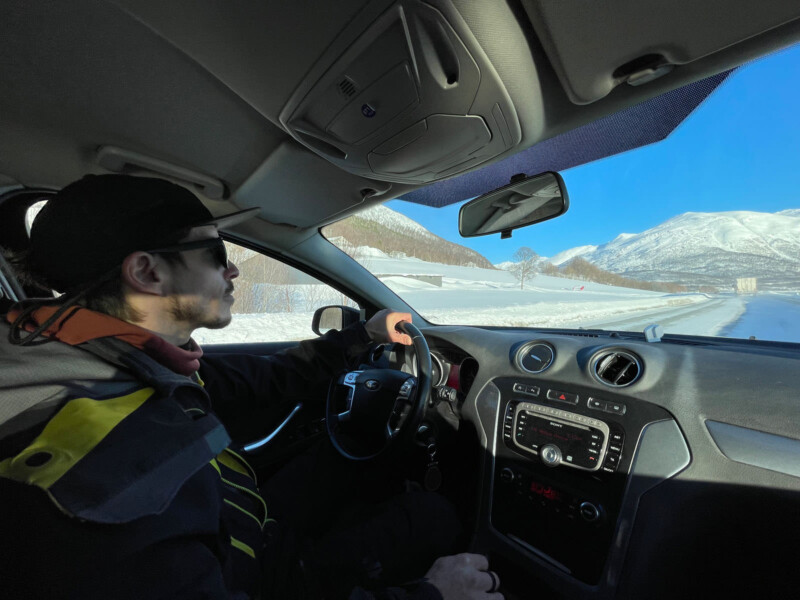
Able to park just by the beginning of the summer track, we geared up by the side of the road. It was -16 degrees C when we parked the car and started to undress.
![]()
![]()
![]()
![]()
We knew the total elevation gain would be about 900 meters high, with firstly a steep and dense forest part, followed by a beautiful opening into the valley revealing great views on our platform. On our way into the forest, we could already see the Platform and realized it was going to be steeper than we expected.
![]()
We decided not to put pressure on ourselves and stuck to the plan, which was to hike to the bottom of the 47-degree slope representing the final 200 meters and see what the snow looks like and how we feel.
At least 5 times on the trek, Maria and I found ourselves saying out loud “That does look very steep on the last part.” We were advancing toward the last section and our feelings were so mixed. Will we actually find a way to go up, or will it be too icy and unsafe to make this shot happen? Both, Maria and I, had big doubts regarding this climb.
![]()
![]()
![]()
Without knowing it, we had unintentionally chosen one of the best aurora night displays in 6 years to do this mission; but this represents about 10% of the work to capture The Platform. I was not expecting such activity, but during the afternoon, I noticed the very strong magnetic disturbance showing in Alaska and realized this same one was going to hit us during the evening. A perfect night to attempt this project.
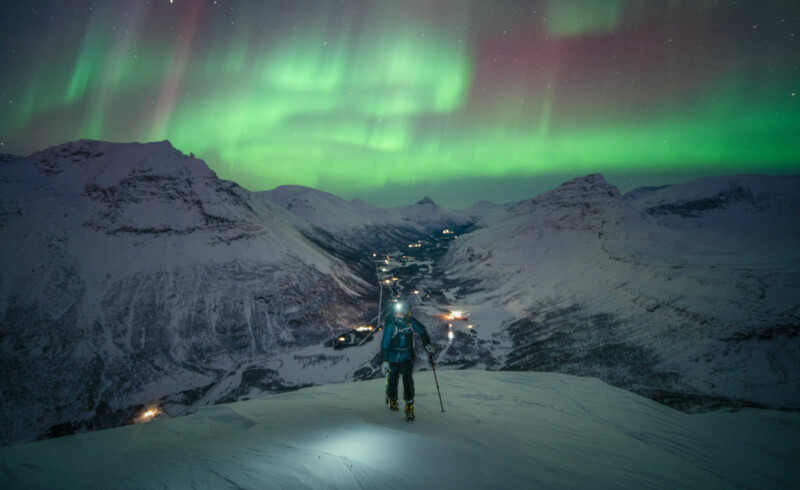
We arrived at the bottom of the last section, and we made the decision to leave our skis, snowshoes, and snowboard on the way, at the bottom of that steep part, and place a waypoint on my GPS to make sure to find it back when we descend down during the dark night.

![]()
![]()
The Ascent
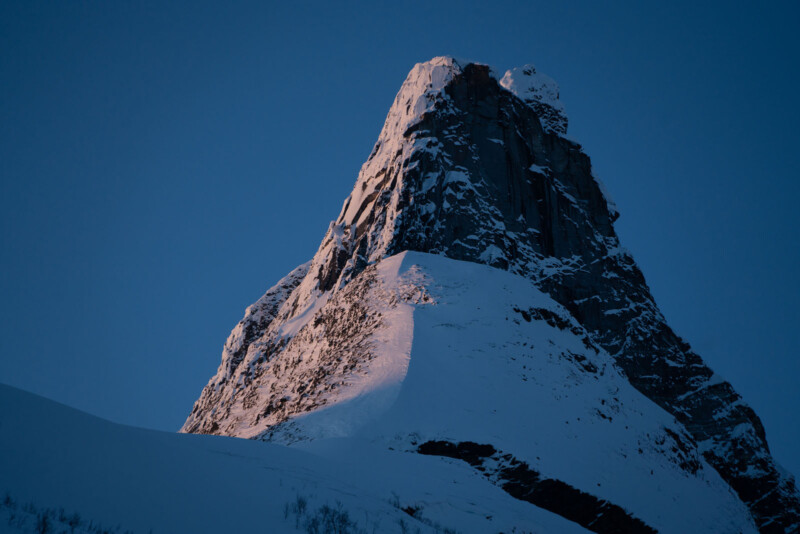
We started the ascent of this 47° steep final section of snowy slope when it was blue hour, the temperature was -21°C, and the auroras were cranking in the south. We took a few images with our phones, and I saw an incredible opportunity to capture an image like I always wanted to have.
I could not resist snapping this adventurous image I titled Blue Ascent that left us both speechless.
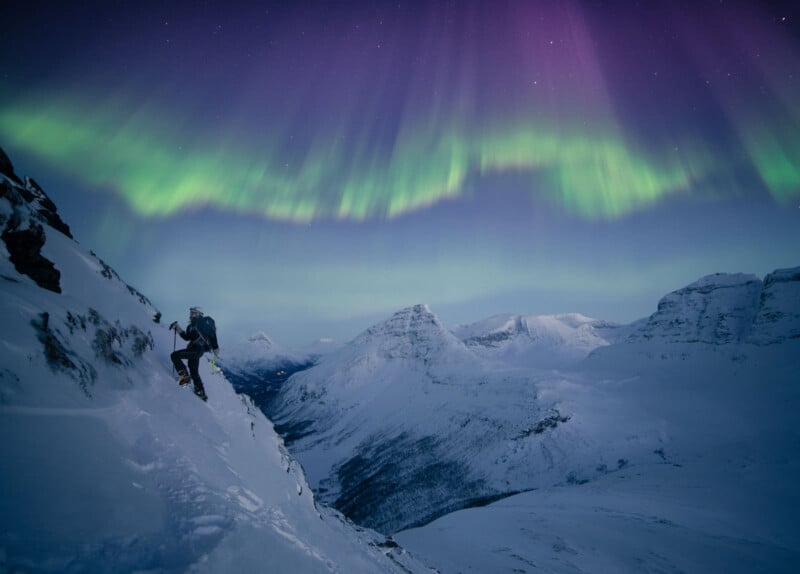
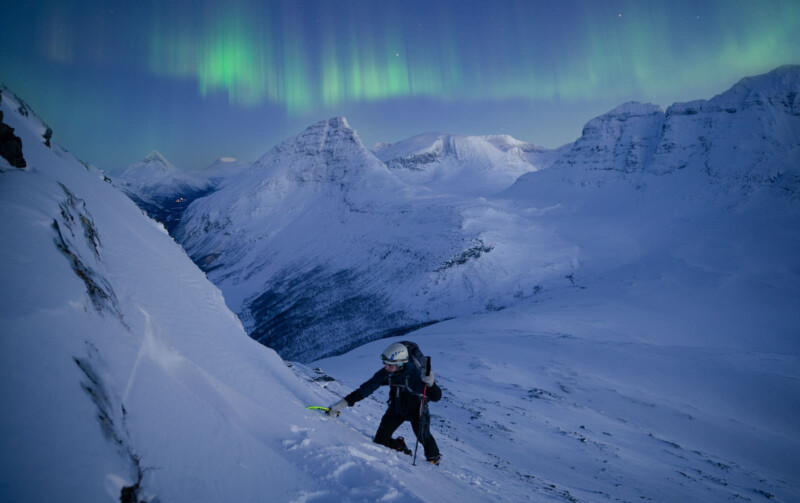
During the whole way up, we got hammered by emotional elevators, thinking “It’s not gonna happen”, because we could not find a safe passage upward until we did, kept ascending 10 meters, and felt stuck and doubtful again. Going up is tricky, but we were also thinking of how would be going down. It is a crazy feeling to see that you are literally 50 meters away from your goal and that you may not end up being able to set foot on it.
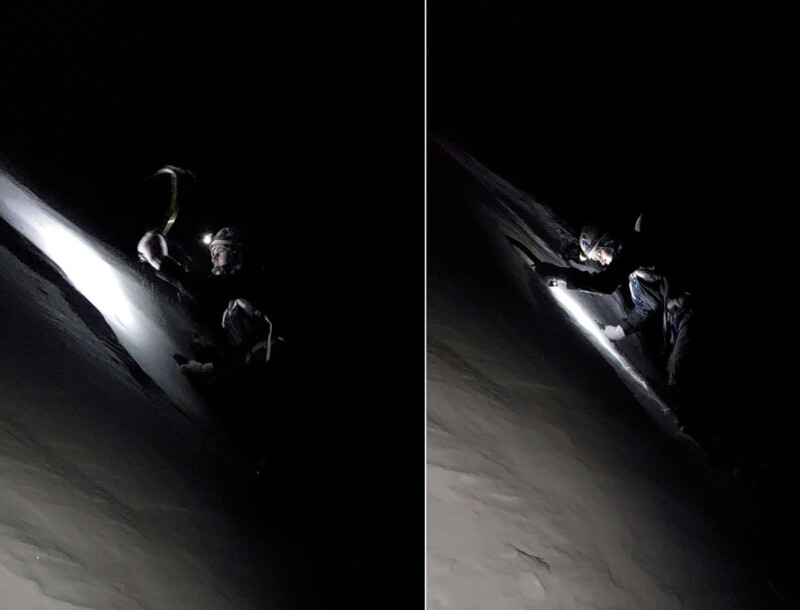
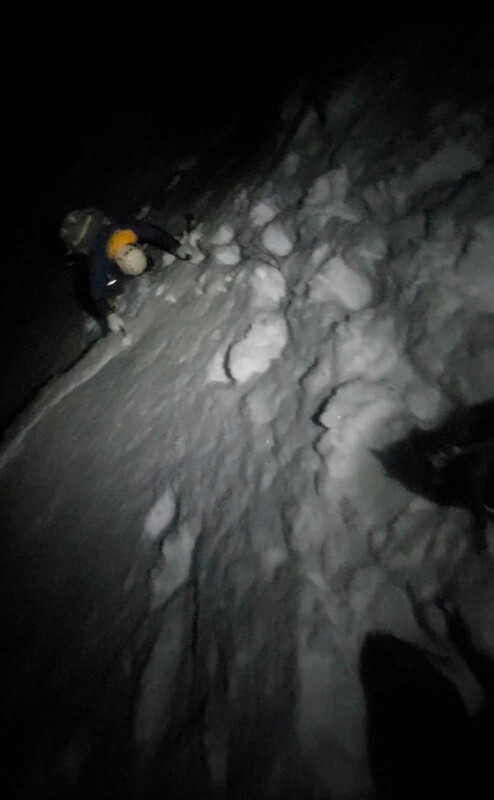
As we ascending the steepest point, I could hear Maria sinking her ice axe into the 20cm thickness of compact snow and yelling “But where is this f**king platform?!”
Once we passed the steepest part, Maria (in front of me) started to see the tip of the cliff and exclaimed: “I see the cliff! I see the cliff!” I think I will remember this kick of adrenaline it gave me for quite a while. I could only think “No way, we made it… Now, how is the sky?”
We faced the cliff, standing on the platform, and the aurorae were dancing above us; the jackpot. It is 21:26, we made it on top and the conditions are exceptional.
I set my camera on the tripod, directed Maria into the frame, and started shooting on f/2.0, 6s, and about 1600 ISO. At this moment my aim was to catch the colorful sky and capture all the images I needed to capture all in a raw, as fast as possible to keep that homogeny light on my foreground. This way, I have a full vertical panorama on which the aurora colors and intensity are cast on the snow foreground giving it that united glow and tones.
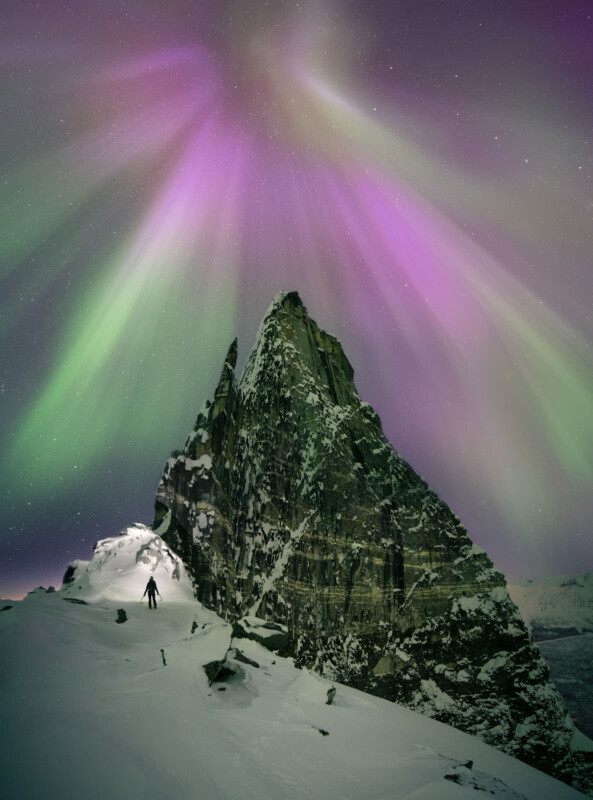
With the images safely in the SD card, the only thing I then wanted was to get back down safe and happy.
On our way down, my camera was strapped against my chest, and I have to say I am still surprised at how resistant it is. Under these extremely cold temperatures, my front display and viewfinder became completely frozen, and my fingers were sticking to the metal of my lense making it very hard to operate.
![]()
I usually always fill up my bottle of hot water hoping it will not freeze that fast, but the cap part got frozen within an hour, making the hydrating part very complicated.
We eventually arrived back to our car with an SD card full of amazing images that I hoped would produce the result I needed to get everything together and make the project happen.
After 6 and half hours spent outside under -21 degrees C, I can insure that being back in a warm car, drinking a hot chocolate, and eating a protein bar make you feel like you’re in a 5-star hotel.
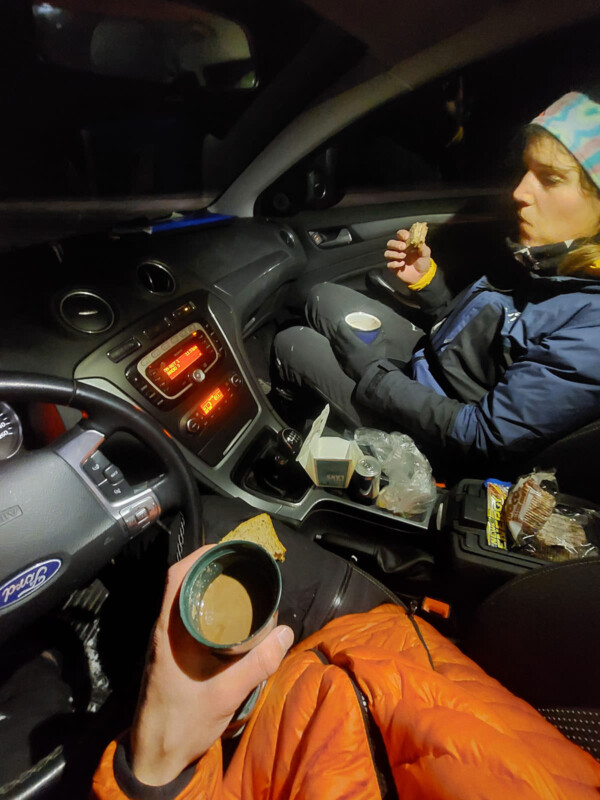
The aurora borealis is an incredible phenomenon I have fallen in love with because it is always different in shape and color. Every single appearance of these green dancers in the sky is unique.
Creating images like such has become an obsession. It drives me to always be more creative and build strong images that no one has taken before, and that no one will ever take. This is what makes an image unrepeatable with a unique story behind it.
About the author: Virgil Reglioni is a fine art polar landscape and aurora photographer based in Norway. You can find more of his work on his website, Facebook, and Instagram.